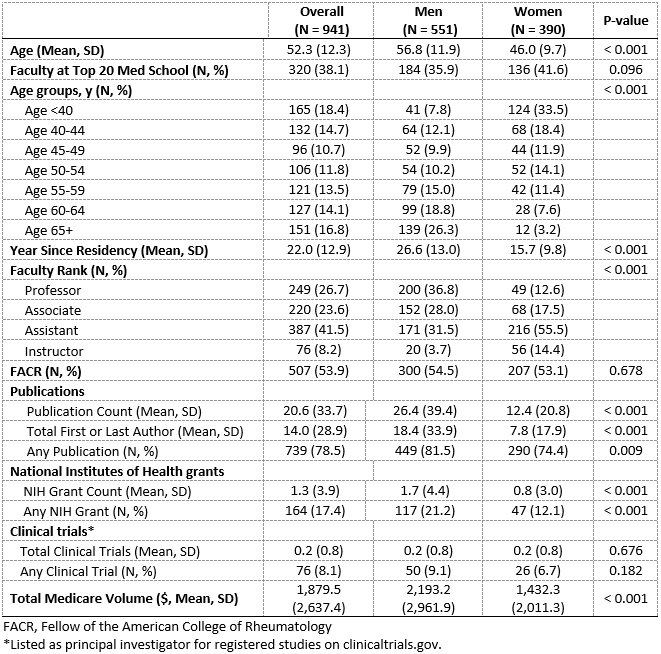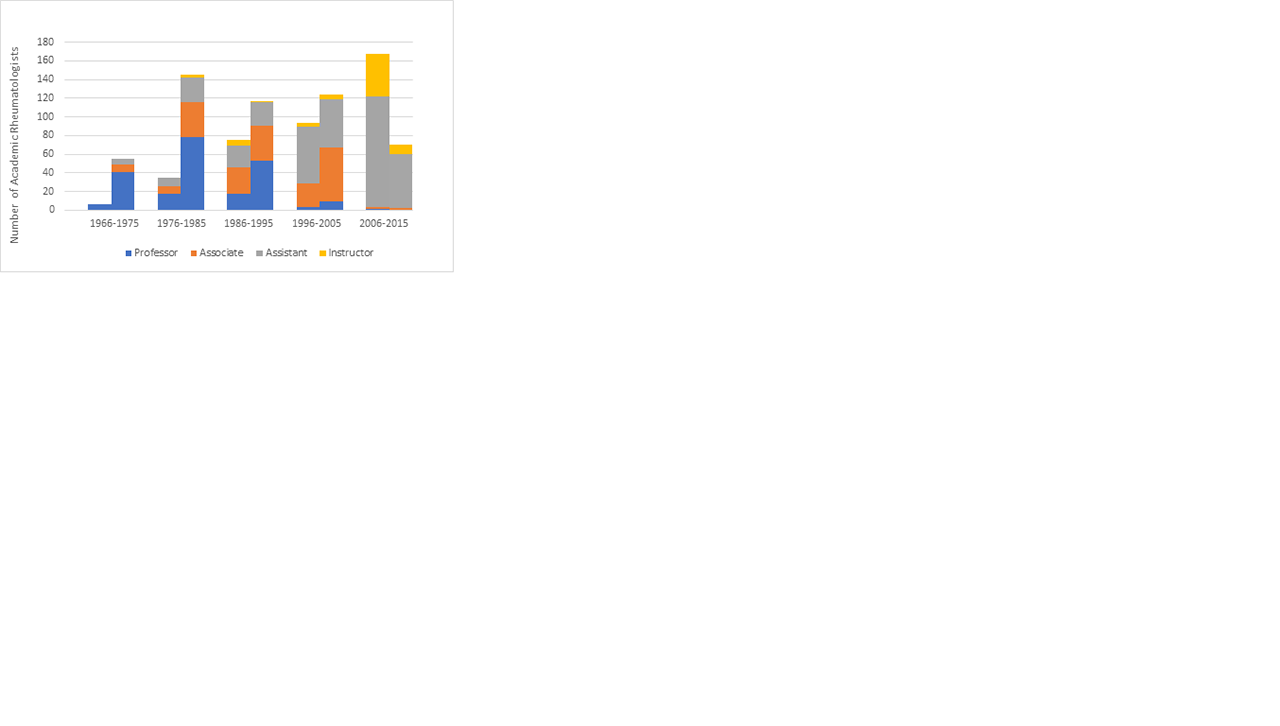Session Information
Session Type: Poster Session (Monday)
Session Time: 9:00AM-11:00AM
Background/Purpose: In contrast to historical trends, women now comprise more than half of rheumatology fellowship graduates in the United States (US). Differences in academic rank according to sex have been found in some medical specialties. Our objective was to determine the association between sex and academic rankings among US rheumatologists.
Methods: We identified all practicing US rheumatologists in 2015 using a comprehensive database of all licensed US physicians maintained by Doximity, an online physician networking service. This database contains several demographic and professional characteristics of U.S. physicians. Among academic rheumatologists, we determined the proportions of Professors, Associate Professors, Assistant Professors and Instructors among men and women. We compared sex differences in physician age, years since residency graduation, number of publications (from PubMed), number of National Institutes of Health (NIH) grants, registered clinical trials (from ClinicalTrials.gov), appointment at a top 20 medical school (as ranked by U.S. News and World Report), and total Medicare volume (obtained from Centers for Medicare and Medicaid Services). The primary outcome was the odds of being a Full Professor or Associate Professor, and the exposure of interest was sex. We used logistic regression to estimate the odds ratio (OR, 95% Confidence Interval) of Full or Associate professorship (vs Assistant Professor) by sex after adjusting for the above covariates. We also examined faculty rankings by 10-year period of residency graduation among men and women.
Results: Among 6,125 total practicing rheumatologists, 941 (15% overall) had academic faculty appointments in 2015, and 390 were women (41%). Women academic rheumatologists were younger (mean age 46.0 versus 56.8 years, p< 0.001) and completed residency more recently (mean 15.7 versus 26.6 years ago, p< 0.001) than men. Women had fewer total publications, first or last author publications, and NIH grants (Table 1; all p< 0.001). In unadjusted analyses, women academic rheumatologists were less likely to be Professor or Associate Professor than men (OR 0.52 [95% CI: 0.45-0.60]). These differences persisted within 10-year periods of residency graduation (p=0.015 for 1986-1995 and p< 0.001 for 1996-2005) (Figure 1). In fully-adjusted analyses, women were less likely to be Full or Associate Professors (vs. Assistant Professors) than men (aOR 0.76 [95% CI 0.59-0.99]. However, the adjusted odds of being a Full Professor (vs. Associate Professor or Assistant Professor) were similar among men and women (aOR 1.07 [95% CI 0.78-1.49].
Conclusion: Among academic rheumatologists, women are less likely than men to be Full or Associate Professors. While differences in workforce age explain some of these observations, they persisted within 10-year periods of training completion. To address these disparities, barriers to the advancement of women in academic rheumatology should be addressed, such as differences in research productivity, and how contributions to innovation, research, and education are assessed in academic promotion. As the workforce gender balance shifts in coming years, academic advancement of women in rheumatology should be fostered.
To cite this abstract in AMA style:
Jorge A, Fu X, Blumenthal D, Gross N, Bolster M, Wallace Z. The Association Between Physician Sex and Faculty Rank Among Academic Rheumatologists in the United States [abstract]. Arthritis Rheumatol. 2019; 71 (suppl 10). https://acrabstracts.org/abstract/the-association-between-physician-sex-and-faculty-rank-among-academic-rheumatologists-in-the-united-states/. Accessed .« Back to 2019 ACR/ARP Annual Meeting
ACR Meeting Abstracts - https://acrabstracts.org/abstract/the-association-between-physician-sex-and-faculty-rank-among-academic-rheumatologists-in-the-united-states/


